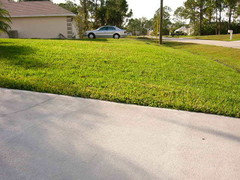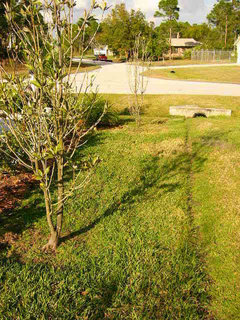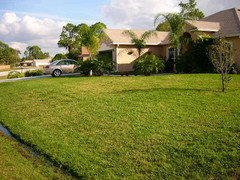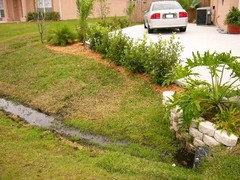When can CGM be applied?
I'm using CGM for the first time this year. I had a very bad experience using Vigaro Weed and Feed last September. After waiting for roughly 6 -8 weeds for my St Augustine grass to grow back after buring it severly, I decided to go Organic. I haven't used any chemicals since this shameful experience. I composted to lawn and also added sugar. I now want to apply CGM before the spring weeds start growing again. I've read articles that said March was a good month to apply the CGM but since I live in zone 10 (Palm Bay FL) things really don't seem to go completely dormant. All responses are greatly appreciated. I am new to posting so please be gentle. :)
Comments (29)
dchall_san_antonio
16 years agoYou're not alone. Weed and feed products are a bad experience for many people.
If you are worried about crabgrass, then you might just get into the habit of applying CGM periodically all year long. In your climate you cannot really know when it might start to sprout but you can be sure it will sprout all spring and summer. I would not wait until March. I know you have plants growing all year long, but if you have any plants that seem to sprout early in the spring (like February), that is the time to apply CGM for the first time. Let Nature tell you when.
One of the problems with preemergent weed killers is that people use it one time thinking they have taken care of all their weed problems. Crabgrass is very aggressive and will take any opportunity to sprout. Any time it gets warm soil (above 55 degrees F), full sun, and frequent watering, it will sprout. What usually works for people is to use a preemergent in the early spring to keep new seed from sprouting. That gives the grass a few more weeks to get dense and tall. Once that happens the chances of getting crabgrass get very slim; however, if you get another problem that results in a thin spot, the crabgrass seed is there, waiting.
Once your St Augustine is filled in and grown up tall (highest setting on your mower), you should not have a problem with grassy weeds. You may have problems with broadleafed weeds like oxalis, black medic, and clover. These can be killed by spraying the leaves with vinegar. They are also relatively easily removed by hand. Just get comfortable and be patient.
skoot_cat
16 years agoCGM could work as a pre-emergent, but its not guaranteed and result vary greatly. If you can find it for a reasonable price, apply in Feb as suggested above. As for weeds you have to apply it before any weed seeds sprout, water in and then let the soil "completely" dry out and repeat (water/dry). I find CGM to be very expensive in FL, and not worth it from what Ive seen.
CGM is an excellent source of protein for your microbes and will make your grass thrive, just don't expect to have a completely weed free lawn. With an organic approach you are going to have some weeds and thats okay. Right? Either pull them by hand or use vinegar to spot spray.
Heres a few tips:
Mow High 4"+: A dense, thriving turf is the best method of weed control. Healthy turf shades the soil so sunlight can't reach weed seeds ready to germinate. A thick turf also minimizes the physical space available for weeds to become established.Watering: Water deeply and infrequently with 3/4-1" of water. No more than once a week in summer or when 30-50% of the lawn shows sign of wilt.
If turf is over-or under-watered, over-or under-fertilized, or mowed too low or too infrequently, the turf is weakened and cannot compete with weeds. Damaged areas resulting from using unsharpened mowers increase time needed for turf recovery, allowing for weed invasion. It is very important to understand that weeds don't create a void, they fill a void.
Related Professionals
Benbrook Landscape Architects & Landscape Designers · Kapaa Landscape Architects & Landscape Designers · Lowell Landscape Architects & Landscape Designers · Suffern Landscape Architects & Landscape Designers · Burlington Landscape Contractors · Dudley Landscape Contractors · Edinburg Landscape Contractors · Goodlettsville Landscape Contractors · Kettering Landscape Contractors · Mason Landscape Contractors · Mission Bend Landscape Contractors · Weymouth Landscape Contractors · La Verne Swimming Pool Builders · Lincoln Swimming Pool Builders · Kendall Fence Contractorsbiggz
Original Author16 years agodchall_san_antonio, Thanks for the immediate response. The experience was pretty bad considering that I take a lot of pride in keeping my lawn up. I remember the day when I was out there looking at the damage and a couple lawn guys was driving by and yelled that I needed to get a service because I didn't know what I was doing. I just shrugged it off. I hand pull all my weeds now, but I must admit that the dollar weeds are challenge. I actually bought some "Image" herbicide but after reading all of the cautions, I just couldn't use the stuff. I pull different sections to the point that my neighbor nicknamed me "Rainman". I just laugh and tell him my lawn adds 10K value to my property and ask him how much value does washing his car twice a week add. Anyway I've read using vinegar to kill weeds but wasn't sure if it would also kill the grass. So I just keep pulling and pulling. I uploaded some pics.
[IMG]http://i220.photobucket.com/albums/dd240/biggz_357/BiggzLawnPictures011.jpg[/IMG]
I have approximately 2500 sq ft of frontage on one side of my property and 750 on the other my lot is pie shaped. On the smaller side I thought I had chinch bugs because must of the grass went brown and nasty looking closest to the ground. After reading the forum and other sites I now think it may have been a fungus.
[IMG]http://i220.photobucket.com/albums/dd240/biggz_357/BiggzLawnPictures010E.jpg[/IMG]
I recently sprinkled (2) 1.5 lb boxes of corn meal. I hope it works.Lastly on the other side of the swale I still have the original Bahia grass, but hope the St Augustine will take it over with time. Biggz :)biggz
Original Author16 years agoskoot_cat, You hit the nail on the head in terms of price. I had to drive 60 miles round trip to buy a 25 lb bag that cost $31.00 with tax. That't way to expensive but I wanted to try the CGM so sometimes you got to pay the cost to be the boss. As I was driving home I stopped at a Walmart and spoke with one of the guys I knew there and he suggested going to the feed store. But every feed store that I called prior to going the 30 miles said they didn't carry it by itself. It was mixed with the feed. But I followed his lead anyway and went to a store that he recommended. The owner was very nice and actually called around to see if he could get it for me as a special order, but as we were talking I asked him about Alfalfa. He said he had it and also had it in rabbit food. He said the rabbit food actually had several different ingredients that would work in a lawn and had other customers that bought it regularly for the gardens. I bought 5 pounds and went home to do some research. They are Rabbit pellets. They have soybean meal, Alfalfa meal, and some other good stuff. I haven't spread it yet because I want to grind it up a little more before I put it in the spreader. But I still need to block those daggum weeds. Biggz:)
dchall_san_antonio
16 years agoDollar weed in St Aug is a problem. There are probably 10 plants that go by the same common name and all are a problem. Some of them are so easily pulled out it would be a shame to spray them with vinegar. You are right that vinegar will kill the grass, too. I make a little cardboard shield to spray weeds. I mark a circle about 2 inches in diameter in the middle of a piece of shirt cardboard. Then I cut the cardboard in half right through the center of the circle. Then I cut out the half-circle on each side. Put the cardboard together again and you have a hole. I center the weed in the hole and spray to keep the overspray off the grass.
skoot cat was right about the effectivness of CGM, at least what he said matches my experience. Preemergent weed control is hard to measure unless you don't spread it on the entire lawn. In my experience CGM makes a much better fertilizer than weed suppression.
Ordinary corn meal should go on at a rate of 10-20 pounds per 1,000 square feet. If you already have a fungus, or you want to do a little heavier fertilization, then apply at 20 pounds. If you are in a preventive mode, applying every 60 days, you can apply at 10 pounds. The best place to get ordinary corn meal is a feed store. And as you have already figured out, call ahead and see if they have it. Around here corn meal has gone up to $8.00 per 50-pound bag.
Molasses is the cheapest at farm and ranch co-ops. They will buy several thousand pounds and sell it to you at the wholesale rate of about $0.10 per pound. You have to bring your own container. A 1-gallon detergent bottle holds about 11 pounds and would cost you about $1.10 per gallon. For anyone in the San Antonio area, the New Braunfels co-op sells it that way.
biggz
Original Author16 years agolou_midlothian_tx, Thanks for these great techniques. The blackstrap molasses can be bought at a feed store? I only hope it will be as cost effective here in Florida as it is in Texas. I actually went to the feed store today and bought a 50lb bag of rabbit food. Purina. It didn't have the ingredients listed on the bag, but I remembered reading a link the listed the different makers of such food and there active ingedients. I'll have to look for it again and save it this time. I'll check to see if salt is in the product, but if memory serves me correctly Purina didn't. I paid $14.00 for the bag. Is that a good price? I'll spread the CGM in 3 weeks for the 1st time. Am I correct that it will take 3 weeks to start seeing the effects of the protein fertilizer? The reason I asked is because I spread 10lbs per 1000 sq ft today. All in all the lawn is starting to grow a little faster but I'm not cutting it for a while and I do cut at 5 in the summer time and 4 in the winter.
dchall_san_antonio, I have some old bottles that I can use for the molasses and the cardboard idea is great. It reminds me of my days in the darkroom when I had a studio up North. In fact I haven't had this much fun in a very long time and really appreciate the advise you folks have shared. Did you look at the links I posted. I'd like your opinion (everyone) on the condition of the grass particularly the smaller area where there's obvious damage. I threw some corn meal down and was wondering how long it will take before I can see a noticible difference. Thanks again, Biggz:)
skoot_cat
16 years agoOkay, I noticed quite a few things from the pics. Try and stay with me here.
First, I know you stated you mow at 5" summer and 4" winter, but from the pics it appears you are mowing way too low. In Pic 1 it looks as if the brown areas have be scalped. Do you use a weed whacker in this sloped area? Pic 2 The grass appears to be the same height of the driveway.
Second, You are either under or over watering from the looks of most of the brown areas. Are those 2 hose end sprinklers your only irrigation source? Are you sure you are applying water evenly? Have you done the tuna can test?
Now, The irregular shape brown area near your neighbors house (pic2) appears to be the disease Brown Patch (also called Rhizoctonia Blight) Its not deadly, just ugly during the dormant season. Im am currently conduction an experiment to treat Brown Patch organically and I will post details and full results next week. For now, you could/should apply CM @ 20lbs per 1000sqft on and around the affected area, water only in the early morning hours and do not mow over that area.
Third, If you are planning on using the CGM for the dollar weed, Im sorry to say it will not work. This is the worst weed in St.Augustine lawns IMO. It spreads by runners and is almost impossible to control once it is established. If you want more info about control email me.
FYI, Your grass is dormant right now and has slowed top growth considerably. This is normal during winter months.
I know its alot, but if you answer all those questions we will be able to help you further. For now do not apply anything else to your lawn.
biggz
Original Author16 years agoskoot_cat, Thanks for getting back. First I do mow at 4 inches currently but I probably need to take a closer picture by the driveway to show that the grass is actually higher than the concrete. In picture (1), I did scalp the grass like a dummy with the mow after I laid some new sod in the damaged areas. In fact all of the brown areas were new sod that I laid over the winter and unfortunately took the same effect as what I replaced. The grass that was replaced was very weedy with crabgrass (creeping Charlie) so I dug it all up and bought new sod for those areas, but I obviously didn't do a very good job in watering as you stated or carefully mowing it. The swale gets pretty muddy and itÂs a nasty deal mowing in those areas. I avoided over watering because I didn't want those weeds to grow back, but I failed since I now have lotttts of dollar weeds. I don't see the crabgrass yet but I fear it's looming in the near future. In picture 2 I actually use 3 sprinklers on that side. I have a pump and use well water for the grass, but haven't installed underground irrigation yet. ThatÂs going to be a project for the spring. There's 1 by the back fence that overlaps the one in the middle and that one is overlapped by the one by the driveway. The one in the middle works on 360 degrees. The middle probably gets more water then the rest of the yard. I didn't use the tuna can test and need too. I was going to spread the CGM for crabgrass that along the outer edge of my property by my neighbor's house. He doesn't do anything at all. Its weed county over there with big ant hills. It's like a mine field, and very dangerous if your not paying close attention. Lastly, how did you post those pictures on the page? I tried but was unsuccessful and would like to post other problems that the forum could analyze closer. Thanks for your help it's obvious I need it and I saw your lawn. Verrrry beautiful.
skoot_cat
16 years agoI believe you, I just wanted to stress the importance of mowing high.
You definitely need to do the tuna can test. Place several tuna cans throughout the irrigation zones to find out how long it takes to apply 3/4-1" of water. Place the cans in the problem and healthy areas of the lawn. Start of with 1/2hour per zone then measure the amount of water in each can and write it down. You can then figure out how long your irrigation system should run for each application. You might need to do this test 2 or 3 times, moving the cans each time to get it just right. After the test, you could also try different configurations of your sprinklers and do the test again. Be sure to test at the same time you normally run your irrigation.
My last post I suggested Corn Meal to the affected areas, but now Im suggesting you Apply CM to the entire lawn @ 20lbs per 1000sqft. Also, at very least spread a light layer of compost on all affected/brown areas of the lawn. A layer of compost to the entire lawn would be ideal.
Is there any way to fix the drainage in the swale?
As for posting pic, you need to copy the html code (not the img code) in photo bucket and paste it into you message.
biggz
Original Author16 years agoskoot_cat, I'll do the test next Tuesday. This past Tuesday was the last time I watered the grass. I couldn't find any corn meal in bulk. I'll try the feed store that I originally bought the rabbit food (alfalfa). The one I went to today gave me the impression that they had it, but didn't want to sell me any since I wasn't feeding an animal. I'm probably just feeling paranoid. Anyway, I bought 5 boxes of corn meal and will treat the lighter area. Do I have to water it in? Maybe my eyes are playing tricks on me but the area appeared to be getting a little darker green. The drainage in the swale has been an on going problem since I built this house because it drains under the roadway to my neighborÂs swale across the street. Unfortunately her lawn people never cut it low enough for it to drain properly and the only way it can be cleared is to call the city to clear it. It does drain off eventually but takes much longer than necessary, so every water loving weed imaginable grows in the swale and eventually into my lawn unless I stay on top of it. As a result of this fact, I'm reluctant to water that side of the property deeply. I'm still waging a battle with the dollar weeds pulling them mostly on the larger lawn and sprinkling baking soda on the smaller lawn. I still have the CGM and was wondering if I should spread it. I just don't want to use it too soon before germination and lose the weed blocking effect. I posted some more pictures of the problem areas and wanted to know if you and the forum think itÂs getting darker or is it just my imagination. Thanks Biggz :)




lou_spicewood_tx
16 years agoGo easy on baking soda. I wouldn't use it if given a choice since it is a strong fungicide product killing beneficial ones as well. You will have to apply compost to the area where you used baking soda on to get beneficial fungi back into the soil.
You should see dramatic green up effect from CGM. Every person that have used it said that it does best job of all the grain based products. I would have used CGM as stand alone fertilizer if it was cheap but I mostly use soybean meal since it offers best bang for the money. You won't see much green up effect from alfalfa pellets but it is a good solid all around. I prefer soybean for the ease of use. Just throw it in the spreader and be done after 10 minutes. Soybean has an advantage of being fungal food while alfalfa is more of bacterial food. It's hard to get enough fungi in the soil. You can alternate soybean, alfalfa and corn meal every few months. Or you can mix all three together which is probably the best all around if you're willing to go all the trouble.
I don't use corn meal as much as I used to do. I guess I got tired of corn meal blowing back into my face on windy days. Soybean meal might do a sufficient job of maintaining trichodermia fungi population since it is fungi food but I can't be certain.
Let me give you an advice...
Don't tell feed stores that you're using grains for the lawn... Just walk in, ask for the products, pay and get out. It's just so much cheaper at the animal feed stores, it's worth it getting funny looks from the workers there. I can't bring myself to pay 2-10x the cost for the same stuff at organic oriented garden centers. I feel sorry for the people that got suckered into paying a lot more for the same stuff because they don't know any better.
biggz
Original Author16 years agolou_midlothian_tx, I examined the results of the Baking soda, and feel I've finally found a solution to the dollar weed and weeds in general problems. The baking soda pulverized the weeds. IÂm totally convinced that it is a viable alternative to atrazine. The St Augustine is still growing strong with no damage worth mentioning. I used baking soda last year in the backyard (Bahia grass there) and unfortunately because of run off it killed a beautiful Night Blooming Jasmine, so the decision was made not to use it anymore. My wife gave me grief for months since she bought the plant originally. I've since replaced it with another and propagated it for an additional 2 plants. I stay far away from those plants with the baking soda though. I also applied compost to the treated areas. I've decided to spread the CGM this week. I hope it's not too soon, but as I was pulling some weeds the other day I noticed some small weeds with what appeared to be seed heads. I think it's time to apply it and hope for the better. I'll do the tuna test this week as "skoot_cat" suggested to get a better idea of the water distribution. I have a question. Has anybody had any experience with ScottÂs organic fertilizer? I was at the local Home Depot today and notice it is 11,2,2. That much more nitrogen then Milorganite, and a little more than the CGM. The cost is $16.99 in my area. Much cheaper then what I paid for the CGM $29.99
lou_spicewood_tx
16 years agoI am familiar with Scotts organic fertilizer. I don't think it's anything special but it's better than nothing. I would still recommend soybean meal if you can find mainly because it is fungal food and they help beneficial fungi grow in the soil. I've talked to Soil Food Web expert and she doesn't seem to be impressed with Scott's organic fertilizer. What you really need is to focus on growing fungi in the soil. It's very easy to grow bacteria but not fungi and it takes time to grow enough fungi in the soil. They hold more water, keep nutrients from washing away, etc.
Stand back. In about 2-3 weeks, you'll be mowing everyday... :)
biggz
Original Author16 years agoWell I finally had time to do the tuna can test and spread the CGM. I only applied 10 LBS per 1000 sq. ft. since the largest bag they sold was 25 LBS. and I had to do approximately 2500 sq ft on one side. The CGM is very expensive in my area ($29.99 for 25 lb bag) and I didn't feel like spending $60 plus for a product that may not work as well as I hope. I read where I shouldn't see a major reduction in weeds for the initial application, but some moderate control should be expected. I'm fine with those results since I pull most of the weeds and now that I'm using the baking soda for the dreaded dollar weeds and crab grass, I'm at least armed to do battle. I'm surprised that I hadn't received more response to my question about the "Scott's organic fertilizer, but do appreciate Lou's opinion. Lou you said the soil expert wasn't very impressed with the product. Could you elaborate more as to what didn't impress her? From the ingredients that I remember seeing listed, I was under the impression that they made pretty good "soil food". I haven't had the chance to go back to the original feed store where I bought the alfalfa (rabbit food) meal as yet to see if they carry soy bean meal but did research it and read it has a nitrogen reading of 7, which is still more then the Milorganite. If the price is right that may be the way to go. Another thing, how long should I wait before applying more food (fertilizer)? I read enough good remarks regarding SBM and would like to try it sooner than later. Thanks again, Biggz:)
lou_spicewood_tx
16 years agoQ. What is the product made of?
A. Primarily protein ingredients derived from Hydrolyzed Feather Meal, Meat Meal, Bone Meal (bovine-free), Blood Meal and Sulfate of Potash.- Nitrogen: derived from feather meal, blood meal, meat meal, bone meal
- Phosphorus: derived frm bone meal
- Potassium: derived from sulfate potash, which is a mined mineral from the Great Salt Lake
Q. Where are the protein ingredients sourced from?
A. Protein ingredients are all "non ruminant" and are derived from poultry (primarily) and swine byproducts.MEAT MEAL???
The problem I see is that I don't know if the ingredients feed fungi or not. I buy soybean meal because it is fungal food and probably helps support trichoderma fungi to help fight off harmful fungi. Dr Elaine Ingham (Soil food web) always stresses the importance of growing sufficient fungi population in the soil. I don't think Milorganite does that job either.
I wouldn't touch baking soda if somebody held a gun to my head. I'd stick to much more benefical unsulfured molasses and take my time to gradually weaken weeds over time. At least I did see one website advocating the use of molasses to fight dollar weed...
Ntirogen is of less importance in organic program although it helps but over time, you do not need to provide much nitrogen because of much improved nutrient cycling where a lot of nitrogen is cycled rather than wasted away found in synthetic program.
Dchall pretty much exclusively uses corn meal which doesn't have very much protein and his lawn still stays greener than most neighbors.
Every organic fertilizer product is different so you should look deep into each ingredients and what they do for the soil biology then decide what is best for your lawn. In my case, my primary fertilizer is soybean meal but will occasionally use alfalfa and corn meal every once in a while to feed wide diversity of microbes.
If Scott's organic fertilizer is the only affordable choice you have in your area, use it. it's better than nothing.
biggz
Original Author16 years agoLou thanks for the detailed explanation. I guess my main concern is the light patch of grass that I thought was getting darker. It still seems to be but not as fast as I'd like it too. I read the thread that "skoot_cat" started today regarding the tested patch on his lawn. I too added corn meal but obviously not enough. I also noticed that he applied sugar to a portion of the area. Your explanation of using molasses and its added nutrients could be what I'm missing, since I noticed an improvement on the portion that he applied the sugar. My problems are getting the necessary micro food needed to achieve the results that many on the forum have witnessed. I went to the feed store today and they didn't stock 50lb bags of SM. They said they could get it but it would take a week and cost $20 for 50lbs. Now, I know that I never purchased it before but that seems a little high to me. I can't find anyone that stocks 50lb bags of CM either. That means that I have to go to Wal-Mart and buy Quaker Oats and pay $1.19 for 1.5 lbs. I know it sounds like I'm crying here, but I do see the benefits of the organic system and will not use chemicals on my lawn. Home Depot is the only place that I have been able to find Milorganite lately or the Scotts but my heart is telling me that the grains are the way to go. The other thing is applying the molasses. I have no luck with hose applicators. Can I mix it and use a 1 or 2 gallon sprayer since I'm very comfortable with that type of applicator. If so, how much should I mix? I know I can at least get that easily. Here in Palm Bay we have one feed store, and you know what happened the last time I was there, then there's the store approximately 40 miles round trip. That's not a long distance and the owner is a nice guy, but they just don't have everything I want and the prices just seem to be a little high. I guess it's the rich mans feed store. LOL Thanks Biggz:)
lou_spicewood_tx
16 years agoGiven the choice, I guess I'd go with Scott's organic fertilizer since it covers 4000 sqft followed by UNSULFURED molasses spraying. You can find a bottle of molasses at any grocery stores by the syrups are, not sugars (at least my stores does). Ortho Dial sprayer works great. You just set at 2oz and spray till the container is empty. I know the usual recommendation is 2oz per 1000 sqft so figure how many sqft you have and pour the amount of molasses in the container based on the coverage and fill in the rest of the container with water. Do a trial run first to get an idea of how much ortho dial sucks up over certain coverage of the lawn at 1 oz, 2 oz, it doesn't matter as long as the whole bottle is gone for the backyard or front yard.
skoot_cat
16 years agoI just did a google search for Palm Bay FL (its near Melbourne correct) I pulled up google maps then searched for Feed in the "search nearby" and it came up with about 10 places close to Palm Bay. Try it and call around.
Florida is not the best or cheapest place to buy feed grains. I have called every feed store in Pinellas county and beyond and no one carries CM or SBM. They can order me SBM but not CM. The last bag of SBM I bought was $19.00 for 50lbs. I did find a place in Ft.Myers, where my sister-in-law lives that carries SBM for $13.00 for 50lbs. So the next time I go, Im going to get a few bags.
For CM I do 1 of 2 things. I buy cracked corn from the feed store and grind it my self. Or, go to my local Organic/health food store where they have bulk grains and have them order me a 50lb bag. They gave me a 20% discount for buying in bulk and I think I paid $21.00 for 50lb of Certified Organic CM. You could also use the cracked corn,(without grinding) it just takes longer to break down and become effective.
I used the scotts organic 1x last year and had good results with it. I plan on using it for 1 of my 4 feedings this year/ongoing. If I could find more affordable grains I would use them exclusively. But, in FL its hard to do.
Just so you know CGM has to be applied at 20lbs per 1000sqft to have any hopes of pre-emergent effect. Otherwise you are just feeding your microbes. Either way nothing lost.
So what where the results of the tuna can test?
biggz
Original Author16 years agoOK Lou, I have an update on my grain hunt. I did a search on Google and found a feed store that stocked SBM this morning. In fact, I bought 50 lbs today for $14.23 locally. I also bought molasses (Grandma's) at Wal-mart, so tomorrow I'll apply the molasses to the entire lawn. I don't have an Ortho dial sprayer so I'll mix 2 ozs per gallon and treat 1000 sq ft, use a basic pump hand sprayer and hope for the best. None of the feed stores that I spoke with stocked CM, so I'll continue to buy the Quaker Oats brand at the local store until I find an alternative. I took a close look at the blades of grass that has the yellowing and noticed that the grass blade was green (give or take a few) except for the tips. I also noticed that the majority of the new growth if not all inspected was green. This was very encouraging since I started to wonder if the initial alfalfa treatment was contributing to the discoloring. I must admit that I'm a little lost since I've applied alfalfa, 10 lbs per 1000, CGM 10 lbs per 1000, and CM approximately 4 lbs to the problem area 150 sq give or take 50. I think I'm going to hold off on applying anymore grain until I see significant improvement on the damaged area.
skoot_cat, I repositioned the sprinklers so that each one (there are 3) is shooting into the lawn. The configuration that I was using originally had 2 shooting into the lawn overlapping the one that was in the middle covering 360*. I noticed the 360* area is the same area that has the discoloration. The test on the original configuration showed that I get 1 inch of water in 2.5 hours but the center got 1 inch in 1.25 hours. The center was definitely getting over watered. The new configuration has each sprinkler covering a specific area with minimal overlapping and an inch is achieved in 2 - 2.5 hours. I'll see how this works for a while, but the coverage is actually better with minimal wasted water. skoot_cat, you're breaking my heart regarding the CGM. I'll have to drop another $31.00 plus gas. That's $62 bucks and I'm not sure if the results will be worth the money. I haven't read where you guys are truly convinced that CGM is a great pre-emergence. Thanks Biggz :)
lou_spicewood_tx
16 years agoBiggz, it isn't a bad price for 50lbs of soybean meal. 15lbs per 1000 sqft is sufficient. I don't think that hand pumped sprayer isn't gonna do much since it won't get into the ground. That's why I use ortho dial sprayer. More water to wash molasses into the ground. If you have a pick up truck, you're much better off spending money on good quality finished compost than buying expensive CM from grocery store. Beneficial fungi in the compost should take care of BP and SBM should help support their growth from there on.
Don't worry about CGM. It's not worth spending that much money. In fact, I haven't used one in 3 years. Mainly soybean meal and molasses spraying. I don't have major weed problems to speak of. I just mow high around 4 inches and water when needed. That's all.
biggz
Original Author16 years agoHi Lou, I finally had a chance to respond to you last post. I bought an Ortho sprayer like you suggested and applied the molasses. I also rechecked the amount of water that the lawn's been getting. I found out that my first test was incorrect. My latest results were 1 inch of water in 4.5 hours. Does that seem correct? That's a lot of water even from the well, but that was what was calculated in the last test. The grass is slowly starting to green up in the problem area. I gave the lawn the first application of SBM today and watered in some molasses. That Ortho sprayer is much better than the hand sprayer, but I do like the apparent shine left on the grass after using the hand held. Thanks again. Biggz:)
skoot_cat
16 years agoBiggz - STOP
DO NOT APPLY anything else to your lawn until May. Its going to take 3-4weeks to see any results. You have not do any damage, but you have applied more than enough grains to feed your microbes.
Spring growth will be here any day now and you will see a big improvement in the health of your lawn. Give it time, the microbes are working for you as we speak. You may not notice it now, but whats going on in the soil will benefit your lawn very soon.
skoot_cat
16 years agoAbout the watering:
The test could very well be correct. According to the test your applying approximately 1/4" of water per hour.
That's a lot of water even from the well, but that was what was calculated in the last test.
Think of it this way. If it takes you 1 hour or 4 hours to apply 1 inch of water, Its still 1" of water, no matter how long it takes. Thats why the test is so important, you know how much water you're applying in each zone and your not guessing.
With sandy soil here in CFL you will be fine applying 3/4 inches of water per application. I apply 3/4" about every 5-7 days in the middle of summer.
Do the test again at the same time you normally run your irrigation. Early morning hours between 1-7am is the best time to water. Place the cans at random (about 10 cans per zone) the night before. Run your irrigation for at least 1 hour per zone. Generally you want to shoot for 3/4" to 1" of water in each one of the cans.
This is one zone where talking about, correct?
lou_spicewood_tx
16 years agobiggz,
you won't see anything till next month. you'd probably wish you hadn't put down SBM because of explosive growth and a lot of mowing. I meant to say go with SBM for next feeding like in May since you had already used CGM. No big deal. More food for microbes.
It takes that long time to put in one inch of water in per zone or for the entire lawn?
You might want to look into mycohizzal fungi (never could remember how to spell it right). It might help prolong time between watering. You basically core aerate and put down compost mixed with mycohizzal fungi then water them into the holes. Fine screened compost mixed with myco fungi might be the greatest improvement you can do for the soil.
biggz
Original Author16 years agoMan Scoot, I'm glad you told me to stop. I thought I may have put down to much grains but wasn't sure. I hope this didn't mess things up much. Actually spreaded 12 lb SBM per 1000 sq because of the CBM that was already in the lawn. I guess the microbes are feasting right now. They feel like we do after Thanksgiving dinner.LOL This area's been getting a lot of rain since the weekend, (in fact it's raining now) so I won't water for another 7 - 10 days. I have to admit, I'm gradually seeing improvement in the suspect areas (greening up nicely).
Lou, I'm glad that I get my exercise cutting the grass. By the way, can I continue using the molasses, say each cutting? I gave it the Ortho treatment the last time I cut the lawn. Once it dried, I took the hand sprayer and sprayed it again. The grass was really looking great. A couple of neighbors was scratching their heads wondering why the grass had a slight shine. Thanks Biggz:)PS: Does non floating mulch really work?
lou_spicewood_tx
16 years agoIf you have bad weed problem, try every month otherwise do it every 3 months when you put down fertilizer.
Slight shine... Hmmm I;d have to wait for a couple months before I try that!
biggz
Original Author16 years agoOh the agony. No grains, no molasses for 3 months... I guess I'll be bothering folks on the palms, and tropicals forums.lol Thanks guys for all your help. I'll just cut it high and water it deep.:) Biggz


















lou_spicewood_tx